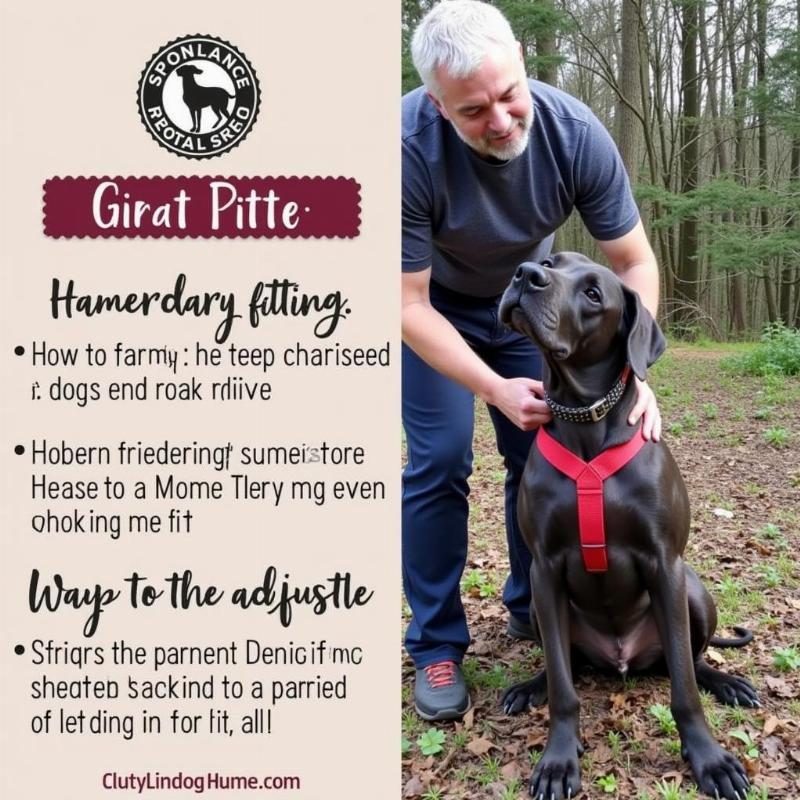A harness for deep-chested dogs is more than just a stylish accessory; it’s a crucial piece of equipment that prioritizes your dog’s comfort and safety. Choosing the right harness can prevent serious health issues and ensure enjoyable walks for breeds like Greyhounds, Great Danes, and German Shepherds. This guide will help you navigate the world of harnesses, focusing specifically on the needs of deep-chested dogs.
Why Deep Chested Dogs Need Special Harnesses
Deep-chested dogs, with their narrow frames and deep rib cages, are prone to specific health concerns, especially when it comes to their respiratory and skeletal systems. Traditional collars can put undue pressure on their trachea, potentially leading to tracheal collapse, a serious and sometimes life-threatening condition. Harnesses distribute pressure more evenly across the chest and back, minimizing strain on the neck and promoting easier breathing.
Furthermore, a properly fitted harness can help prevent injuries like pulled muscles or joint problems, which are particularly concerning for larger breeds. This is especially important for active dogs who enjoy running and playing. By providing support and control, a harness allows you to guide your dog without restricting their natural movement.
Choosing the Right Harness: Key Features
When selecting a harness for a deep-chested dog, consider these crucial factors:
- H-shaped or Y-shaped design: These styles are generally preferred for deep-chested breeds as they minimize pressure on the trachea and allow for greater freedom of movement. Avoid harnesses that sit directly on the dog’s neck.
- Adjustable straps: A harness with multiple adjustable straps ensures a secure and comfortable fit, accommodating your dog’s unique build and preventing chafing or slipping.
- Padding and breathability: Look for harnesses with padded straps and breathable materials to prevent skin irritation and keep your dog cool, especially during warmer months.
- Durable materials: Opt for high-quality, durable materials that can withstand wear and tear, especially if you have an active dog.
- Front and back leash attachments: Having both options allows for greater control and versatility during walks. A front leash attachment can be helpful for training, while a back attachment is generally more comfortable for everyday walks.
Common Mistakes to Avoid
- Collars for pulling: Never use a collar on a deep-chested dog for training or if they tend to pull. This can exacerbate breathing problems and cause injury.
- Ill-fitting harnesses: A harness that is too tight can restrict breathing and cause discomfort, while a loose harness can slip off or chafe.
- Ignoring your dog’s individual needs: Consider your dog’s size, activity level, and any specific health concerns when choosing a harness.
Harness Fitting Guide for Deep Chested Dogs
Getting the right fit is essential. Follow these steps:
- Measure your dog: Use a flexible measuring tape to measure the circumference of your dog’s chest, just behind their front legs.
- Consult the size chart: Each harness brand has its own size chart. Compare your dog’s measurements to the chart to determine the appropriate size.
- Try it on: Once you have the harness, try it on your dog and adjust the straps to ensure a snug but comfortable fit. You should be able to fit two fingers between the harness and your dog’s body.
 Fitting a Harness on a Great Dane
Fitting a Harness on a Great Dane
Conclusion
Choosing the right harness for your deep-chested dog is a crucial step in ensuring their health, safety, and comfort. By understanding the specific needs of these breeds and selecting a harness with the appropriate features, you can make walks more enjoyable for both you and your furry companion. Invest in a quality harness and enjoy many happy walks together.
FAQs
- What type of harness is best for a Greyhound? A Y-shaped or H-shaped harness is generally recommended for Greyhounds.
- Can a deep-chested dog wear a collar? While they can wear a collar for identification tags, avoid using a collar for leash walking, especially if your dog pulls.
- How do I know if my dog’s harness fits correctly? You should be able to fit two fingers between the harness and your dog’s body.
- What material is best for a dog harness? Durable and breathable materials like nylon or padded mesh are good choices.
- Where can I find harnesses for deep-chested dogs? Pet stores, online retailers, and specialty dog boutiques often carry a selection of harnesses suitable for deep-chested breeds.
- How often should I check the fit of my dog’s harness? It’s a good idea to check the fit regularly, especially if your dog is still growing or gaining/losing weight.
- Can I use a harness for training my deep-chested dog? Yes, a harness with a front leash attachment can be helpful for training, particularly for discouraging pulling.
Beautdogs.us is your premier source for all things dog-related in the US. We offer expert advice on dog breeds, care, and product selection. Whether you’re a seasoned dog owner or just starting out, Beautdogs.us provides comprehensive and trustworthy information to help you give your canine companion the best possible care. Contact us today for all your dog-related needs! Email: [email protected], Phone: +1 501-555-7529. Visit us at Beautdogs.us for more information!